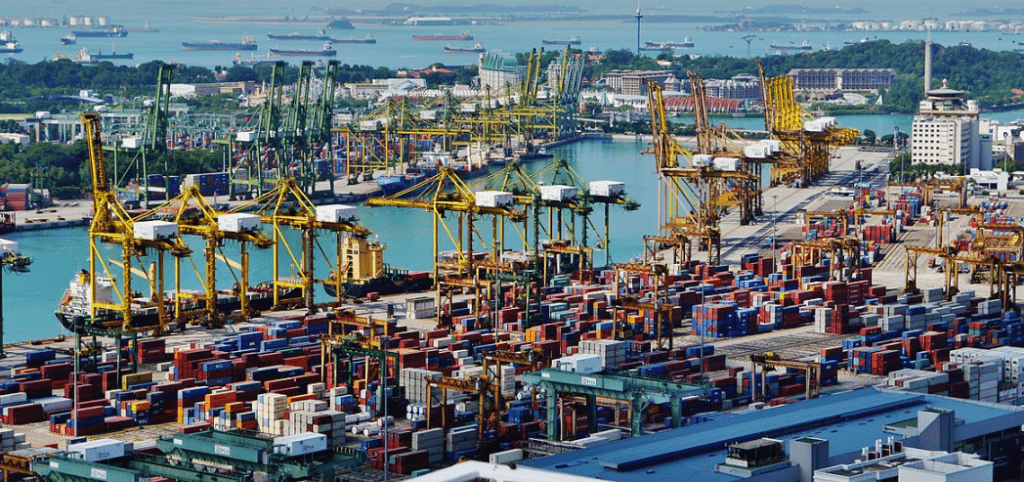By Andy Ford, Unite rep, North West
The idea of the UK as a ‘Singapore’ off the coast of Europe, with light regulation and high growth, has been a recurring theme of the Tory right for over ten years now. Liz Truss was perhaps the leader most openly committed to the idea, but still it remains an influential idea.
For instance, there is Rishi Sunak’s hobby horse of ‘Freeports’ dotted around the country – something he pushed when he was Chancellor under Boris Johnson. In his version, once the “burden of red tape” is removed, these freeports will grow and drag the UK into some sort of high growth, Singapore-style future.
The Singapore Labour Code
But what is the real situation for working people in Singapore? Their terms and conditions are governed by the ‘Employment Act’ (EA) which applies to all workers earning less than $4,500 a month (£3,870 as of today), except seafarers, domestic servants and government employees. The Act gives only 14 days holiday, and a six-day week (with the day off chosen by the employer). There is no minimum wage and employees can more or less be dismissed at will, (in Tory language, ‘no fault dismissal’) – provided only that notice is given. There is no redundancy or statutory severance payment, unless set out in the employment contract.
Anyone who has been to Singapore will tell you that the workforce is structured between Singapore citizens and foreign workers, with Malaysians making up most of the lower status workforce. They will queue for hours to cross over from the mainland, just for a day’s work.
If the foreign workers break any of Singapore’s numerous laws, even just littering or jay walking, they will instantly lose their work permit and face deportation. They can be required to produce this work permit by any public official at any time. If they marry, get pregnant, or bear a child, the work permit can be cancelled.
Conditions worse than for most UK workers
So, whilst even for Singaporeans, the terms and conditions of work are considerably worse than for most workers in the UK, for the secondary workforce of immigrant labour, they have only limited rights which can be withdrawn for many and various reasons.
Of course, none of this is questioned by the Tory ideologues or the think tank creeps who hang on their coat tails and supply their ideas. All they see are the gleaming sky scrapers, the high growth rates, the zero capital gains tax, and agreeable stays in top-notch hotels, where an army of invisible (to them) minions look after their every need.
But is Singapore really a monument to the free market and a lack of regulation? Well, in reality, no. Income tax is very graduated in Singapore, from 2% to 22% in ten incremental steps and is capped at 22%, even for the very wealthy. Yet every employee in Singapore also has to save 20% of their income with the government’s Central Provident Fund (CPF). That is an effective tax rate of 42% for the better-off workers. And employer contributions are another 17%.

Biggest port in the world
Nearly a fifth of the economy is state-owned – airlines, transport, and electricity – but also media and manufacturing enterprises. Not so Thatcherite is it Redwood, Rees-Mogg and Sunak? More like Britain before Thatcher.
The state-owned port at Keppel in Singapore has been ranked as the world’s number one port for nearly 20 years. Again, decades of state-led investment has ensured that it can handle the biggest ships with the most advanced technology, to the point where Singapore handles a third of world container traffic every year. The port is owned by the state investment fund, Temasek, which has assets worth $403 billion across the world, and operates a fleet of 80 merchant vessels. The secondary port of Jurong is also state-owned, through the Jurong Town Corporation which has a mandate to focus on sustainable development.
Nearly all housing in Singapore is publicly built and publicly owned. It is possible to buy a house or an apartment, but most are held on leases and are still government-owned.
In the actual city of Singapore, after decades of government investment, there are superb road, rail, and airport facilities, far superior to the ramshackle privatised systems we see in Britain. Rishi Sunak would have to invest billions of pounds a year to reach Singaporean standards.
The internet in Singapore has 99% connectivity and is verified as the fastest broadband in the world. This also has been government directed through the ‘Intelligent Nation’ programme. Again, so different from Britain. Such excellent infrastructure attracts capitalist investors from across the world.
Singapore is not an ‘unfettered’ free market
Another problem for the think tank dream of Singapore-on-Thames is that Britain is still dependent on trade with Europe and the EU has said that any attempt to deregulate and undercut would meet with tariff barriers to UK goods and services being sold to Europe.
Far from an unfettered free market, Singaporean capitalism has had significant state direction and ownership, to ensure investment. And before running away with the idea of Singapore as some sort of well-run capitalist paradise, it is important to note that it is also one of the most unequal countries in the world, with a Gini co-efficient of 45.9, out-ranked only by about a dozen countries like Colombia, Panama, Zimbabwe and Central African Republic.
The aim of all this investment and infrastructure is to provide a protective cocoon to capitalist development. GDP per person may be high, but the wealth produced is shared out very, very unequally. Maybe that is what really appeals to John Redford, Jacob Rees-Mogg and Rishi Sunak.
As to the actual implementation of ‘Singapore-on-Thames’, it is a pipe dream of deluded right-wing think tanks.



